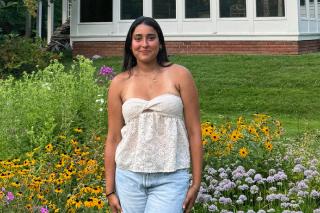Amoli Vad ’28 has published her first paper in a peer-reviewed journal, SRYAHWA Publications Archives of Physical Health and Sports Medicine (6:1, 2024). We spoke with Vad about what inspired her research and why she chose the 3+3 accelerated program at Simmons.
Exercise science student Amoli Vad ’28 was exposed to the medical field at an early age, as her mother is a physical therapist and her father is in sports medicine. However, her interest was piqued outside her parent’s input.
“I play tennis, and I’ve definitely gone through many injuries that needed physical therapy,” she says. “I spent a lot of time in the athletic training office in high school. I would watch and see what [the trainer] did for all of the people there.”
Vad’s interest in the work of physical therapists and athletic trainers has led her to her current course of study: the Accelerated Program in Health and Exercise Science & Physical Therapy (3+3), which combines a Bachelor of Science in Health and Exercise Science with a Doctor of Physical Therapy. Students in the accelerated program can choose to major in Biology or Exercise Science for the undergraduate portion of their studies. Vad opted for Exercise Science.
“The class itself works on fundamentals, on what it’s like to be a physical therapist or athletic trainer,” Vad says, of the Introduction to Exercise Science course she’s taking with Assistant Professor of Practice Tim Hanway. “It’s so interesting and engaging, and we’ve had so many guest speakers! All the people in the graduate courses talk about what they’re learning, and I love hearing it.” Vad hopes to pursue an internship in athletic training working directly with athletes and sports teams during her studies.
Vad’s own experience in the athletic training office in her high school also led to a research project, and her first published paper, “Differences in Proprioceptive Balance between High School Varsity Athletes and High School Non-athletes.”
As part of an International Baccalaureate program, her high school required an individual assessment, including conducting your own experiment and writing up the results. “I wanted to do something that could lead into my field,” says Vad. “I noticed a lot of ankle and knee injuries among people in my age group. Part of the reason is because of balance. One way to help an ankle sprain is to do a balance training program to build ankle stability.”
Vad wondered about the differences between athletes and non-athletes who suffer similar injuries. “Athletes will do a training process or rehabilitation to make sure they are super strong [after an injury], but non-athletes don’t do that. Sometimes non-athletes will be injured, but they don’t have the structure that athletes have.”
For her experiment, Vad took a sample of girls and boys, both athletes and non-athletes, and worked with her high school biology teacher to come up with variables, such as the impact of Body Mass Index (BMI) on balance. “I asked them to stand on one leg with their arms crossed across their chest and eyes closed,” Vad explains. “I set a timer for 30 seconds, but most [participants] wouldn’t make it that long. We did three trials on each leg to get accuracy. For some people, the first 30 seconds were fine, but their [time] dropped as their legs got tired.”
After a month spent collecting data, Vad wrote the report and submitted it to her biology teacher for feedback. Once the International Baccalaureate program graded her report, she was able to share it with her father for further assistance. “He helped me find a team to read the paper and fill in any blanks, and make it a stronger paper. [Their input] allowed me to take a high school paper and transform it into a high-level report, though it was still my original work.” The paper was published in September, with Vad listed as the lead author.
As for the 3+3 program, Vad hopes that more students will consider it. “I knew what I wanted to do, so this program made sense.” Enrollment in the 3+3 also means she won’t have to go through the application process for her advanced degree. As part of the Simmons Edge, an accelerated degree can save both the money and time invested in a student’s course of study.
Vad also encourages high school students to shadow physical therapists, if possible. “See the setting and see what they do. Physical therapists can have different specialties, too, like pediatrics or sports.” For Vad, shadowing physical therapists stoked her interest in the field, so she knew it was a good fit.
“I really enjoy it here in Boston, and Simmons is affiliated with prestigious hospitals in the area,” says Vad. “Being able to study exercise science and play division three tennis makes Simmons perfect for me!”

